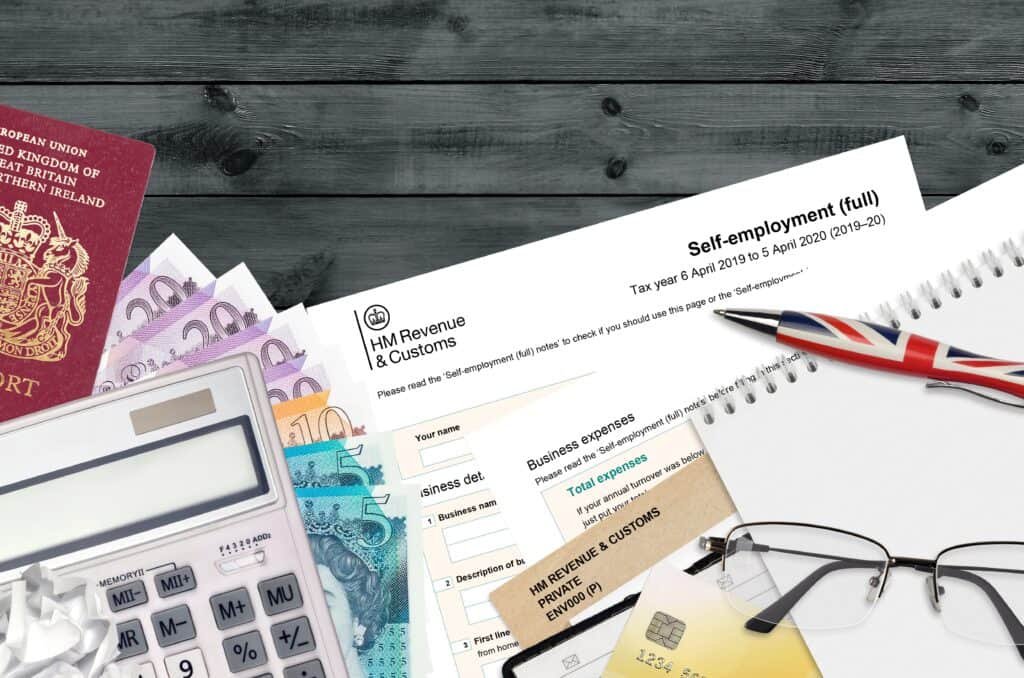How to Spot HMRC Scam Letter and Protect Yourself from Scams

We may earn a small fee from the companies mentioned in this post.
Have you ever received a scam letter claiming to be from HMRC that left you feeling uneasy? In today’s interconnected world, scammers are becoming increasingly sophisticated in their methods, and identifying a fake HMRC letter can be a daunting task.
I have written this article to equip you with the knowledge to spot these scams and protect yourself from falling victim to them.
I will guide you through the process of identifying fake HMRC letters, securing your personal tax account, and responding to suspected HMRC scam letters. You will also learn how to stay informed about the latest HMRC scams and understand your self-assessment obligations. So let’s dive in and start protecting ourselves from these cunning scammers.
Short Summary
Identify HMRC scam letters by analysing content, verifying contact information and being aware of unusual payment requests.
Protect personal tax accounts with secure login practices & regular monitoring activity.
Stay informed on HMRC scams through official updates & online communities to protect yourself from fraud.
Identifying HMRC Scam Letters

Scammers employ a variety of tactics to deceive taxpayers, and one of the most common methods is sending counterfeit HMRC letters. These fake letters may perhaps inform you of an alteration to HMRC’s bank details and request you update your payment methods. This action can result in your hard-earned money ending up in the scammers’ pockets instead of paying your taxes. To avoid falling for these scams, it is crucial to know the red flags and take appropriate action.
It can be difficult to spot a fake HMRC letter. Here are some tips to help you identify if it is legitimate or not. The key lies in analysing the letter’s content, verifying the contact information, and being cautious of unusual payment requests. Let’s explore each of these aspects in detail.
Analysing Letter Content
When assessing the authenticity of an HMRC letter, pay close attention to the language used and the urgency of the requests. Scam letters often have poor grammar and spelling errors, which can be a clear indication of their fraudulent nature. Additionally, be wary of any correspondence that demands immediate action, especially if they claim you owe money.
Genuine HMRC letters do not typically demand “immediate payment” in their initial communication regarding a tax issue. Instead, their first request is for you to contact them to discuss payment and any overdue amounts. Knowing these differences can help you spot a scam letter and save you from potential financial loss.
Verifying Contact Information
Another crucial step in identifying a fake HMRC letter is verifying the contact information provided in the letter. Scammers often use fake contact details to deceive their victims. To ensure the letter’s authenticity, compare the contact information, such as the telephone number, with the official GOV.UK website.
By cross-checking the contact details, you can quickly determine whether the letter is genuine or a scam. If you are still unsure, it is always best to contact HMRC directly and ask them to verify the letter’s authenticity.
Never accept the contact details within the letter, no matter how convincing they may seem, always independently access contact details directly through a search engine such as Google or via telephone enquiries.
Checkout our useful blog on online scams, a guide for the non-technical
Unusual Payment Requests
Scammers are known for making unusual payment requests in their fake HMRC letters. These may include asking for payments in the form of gift cards or vouchers. Be cautious of any requests that seem out of the ordinary, as they are likely scams.
Another red flag to watch out for is being instructed to pay customs duty for a valuable parcel that does not exist. These are common tactics undertaken by scammers and by being aware of these unusual requests, you can protect yourself from falling victim to these fraudulent schemes.
Protecting Your Personal Tax Account

A personal tax account that can be accessed over the Internet is a secure online system provided by HMRC, allowing you to access, review, and manage your tax-related information. Protecting your personal online tax account is essential to prevent unauthorised access to your sensitive financial information.
Two key measures to safeguard your tax account include employing secure login practices and monitoring your account activity regularly. Let’s delve deeper into these protective measures.
Secure Login Practices
The first line of defence in protecting your personal tax account is using secure login practices. This includes employing a robust password, utilising two-factor authentication, and abstaining from using public Wi-Fi networks when accessing your online tax account.
Robust passwords should consist of a combination of upper and lowercase letters, numbers, and special characters. I have produced an easy to understand article on how to create a secure password that you may find useful.
The most secure method to access your online account is to use Two-factor authenitcation. Two-factor authentication provides an additional layer of security, typically through a one-time code sent to your mobile device or biometric data such as a fingerprint or facial recognition.
By implementing these secure login practices, you can significantly reduce the risk of unauthorised access to your personal online tax account.
You may find our article on Two-Factor security useful
Monitoring Account Activity
Regularly monitoring your account activity is another crucial step in protecting your personal tax account. By keeping an eye on suspicious activity or significant details, such as changes in your personal information, you can quickly identify and address potential issues.
Set up notifications to alert you of any changes or suspicious activity in your account. If you observe any questionable actions, contact your bank or financial institution immediately and report the activity. Staying vigilant and proactive in monitoring your account can save you from potential financial loss.
Responding to a Suspected HMRC Scam Letter

If you receive a letter you suspect is an HMRC scam, it is important to take prompt action to protect yourself and others. Ignoring the issue or delaying your response can lead to further complications and financial loss.
The recommended course of action involves contacting HMRC, informing your accountant, and reporting the incident to Action Fraud. Let’s examine each of these steps more closely.
Contacting HMRC

As soon as you suspect a scam letter, forward a copy of the letter to HMRC and request them to verify its authenticity. Be sure to use the official contact details listed on their website, as using the contact information from the suspicious letter may lead you straight to the scammers.
By sending the letter to HMRC for verification, you are not only protecting yourself, but also helping them keep a record of the scam and potentially raising awareness to prevent others from falling victim.
Informing Your Accountant
Sharing the suspected scam letter with your accountant is another vital step in addressing the issue. They can offer valuable advice and guidance on how to proceed and may have experience dealing with similar scams.
Your accountant may also be able to confirm the authenticity of the letter and help you take any necessary actions, such as contacting HMRC on your behalf. By involving your accountant, you are ensuring that you have professional support in addressing the potential scam.
Reporting to Action Fraud
Finally, report the incident to Action Fraud, the UK’s national fraud and cyber crime reporting centre. Reporting scams not only helps protect you, but also helps prevent others from falling victim to the same scam. Provide as much information as possible when submitting your report, including any evidence you have. By taking these steps, you are actively contributing to the fight against scammers and helping protect others from becoming victims.
Staying Informed on HMRC Scams

With scams becoming increasingly sophisticated, it is crucial to stay informed about the latest HMRC scams to protect yourself and others. By following official updates and joining online communities, you can stay up to date with the latest scams and learn from others who have encountered them.
Let’s explore how you can stay informed about HMRC scams through official updates and online communities.
Following Official HMRC Updates
Keep up to date with the latest HMRC news and scam alerts by regularly visiting the official GOV.UK website. The HMRC website offers updates on alterations to tax regulations, tax relief, and details on how to defend yourself from scams.
By staying informed about the latest scams and reporting any suspicious letters, emails, or text messages to HMRC, you are actively contributing to the fight against fraud and protecting both yourself and others.
Joining Online Communities
Another way to stay informed about HMRC scams is by joining online forums and communities. These digital platforms provide a space for individuals to share experiences and gain insight from others who have encountered scams.
You can find online communities on various platforms, such as social media websites, online forums, and specialised community platforms like Discord and Slack. By participating in these communities, you can learn from others’ experiences and stay ahead of scammers.
Subcribe to the joncosson.com website
Scams are constantly evolving, and HMRC scam letters are no exception. These fraudulent schemes can be sophisticated, mimicking official HMRC communications to deceive even the most vigilant individuals.
But there’s good news! By subscribing to Joncosson.com, you can stay one step ahead of the scammers. We provide the latest updates on scams, including detailed insights into HMRC scam letters, practical tips to recognise them, and expert advice on how to protect yourself.
Why trust your financial security to chance when you can have the latest information delivered straight to your inbox?
Join the community at Joncosson.com today and arm yourself with the knowledge you need to stay safe. Our subscribers are the first to know about emerging threats, and we’re committed to helping you navigate the ever-changing landscape of online fraud.
Don’t let scammers catch you off guard. Subscribe to Joncosson.com now and ensure you’re always in the know!
Self Assessment and HMRC Correspondence

Understanding your self-assessment obligations and recognising genuine HMRC correspondence is crucial in avoiding scams. As part of your tax responsibilities, you must submit accurate tax returns and pay any taxes owed on time.
To help you differentiate between genuine and fake HMRC letters, let us discuss the characteristics of legitimate HMRC correspondence and your self-assessment obligations.
Protect yourself from HMRC scam calls, read our informative blogpost and protect yourself.
Recognising Genuine HMRC Letters
Familiarising yourself with the format and content of genuine HMRC letters can help you avoid falling for scams. Legitimate letters from HMRC will include:
The HMRC logo
Contact details
A reference number
A clear explanation of the purpose of the letter and any action required.
By knowing the characteristics of genuine HMRC letters and understanding your self-assessment obligations, you can minimise the risk of falling victim to scams.
Meeting Self Assessment Obligations
In order to meet your self-assessment obligations and avoid any past tax liability, it is essential to:
Submit accurate tax returns
Pay any taxes owed on time
If you receive an official HMRC letter indicating that you owe money, promptly contact HMRC and provide an explanation of your circumstances to create a payment plan.
By fulfilling your self-assessment requirements and being vigilant in identifying genuine HMRC correspondence, you can protect yourself from potential scams and financial losses.
Summary
We have covered various aspects of identifying fake HMRC letters, protecting your personal tax account, and responding to suspected scams. By staying informed about HMRC scams and understanding your self-assessment obligations, you can minimise the risk of falling victim to scams and protect yourself from financial loss.
Remember, knowledge is power. By arming yourself with the information provided in this blog post, you can stay one step ahead of scammers and safeguard your finances from potential fraud.
Frequently Asked Questions
How do I know if the HMRC letter I have received is genuine?
You can check the authenticity of an HMRC letter by contacting the Income Tax general enquiry helpline. Be wary of suspicious requests or language, such as asking you to ‘act immediately’. If it’s the first time you have heard from HMRC about a payment, it is likely to be a scam.
Why did I get a letter from HMRC?
You’ve received a letter from HMRC as part of their annual reminder for self-employed people to file their tax returns on time. It does not mean that you have missed your deadline or made a mistake.
How do I report a scam letter to HMRC?
To report a scam letter to HMRC, forward the email or take a screenshot of any message and send it to phishing@hmrc.gov.uk or text (SMS) to 60599 and request they verify its authenticity.
You could also call the HMRC helpline on 0300 200 3300 to verify whether the letter is legitimate. If there is an intimidating phone call, report it to Action Fraud.
What are some common red flags to spot a fake HMRC letter?
Poor grammar, spelling errors, and urgent demands for payment are all tell-tale signs of a fake HMRC letter. Be sure to look out for these when assessing any correspondence received from the HMRC.
It is important to be vigilant when it comes to HMRC letters, as fraudsters are becoming increasingly sophisticated in their attempts to scam people out of their money. Always double-check the sender’s address.
How can I verify the contact information provided in a letter?
Verify the contact information provided in a letter by comparing it against the official GOV.UK website.
This can help ensure that the contact information is accurate and up-to-date.
What to do if I susspect I recieved an HMRC simple assessment fake letter?
If you suspect that you have received a fake letter claiming to be from HMRC regarding a simple assessment, it is important to be cautious and take the necessary steps to verify its authenticity. Here’s what you can do:
1. Examine the letter for any signs of forgery or inconsistency, such as spelling mistakes, poor grammar, or unusual formatting.
2. Cross-check the contact details provided in the letter with official HMRC contact information available on their website.
3. Contact HMRC directly using the official contact details found on their website to verify the letter’s legitimacy.
4. Do not provide any personal or financial information in response to the letter until you have confirmed its authenticity.
5. If you determine that the letter is indeed fake, report the incident to HMRC and any relevant authorities to help prevent others from falling victim to scams.
Remember to exercise caution when dealing with any correspondence claiming to be from HMRC or any other government agency.
External Refernce Information
- HMRC – GOV.UK
- Website: https://www.gov.uk/report-suspicious-emails-websites-phishing
- Description: This is the official UK government page for reporting phishing and scams. It includes information on recognising HMRC-related scams, including scam letters, emails, and texts, and provides guidance on how to report them.
- Action Fraud
- Website: https://www.actionfraud.police.uk/
- Description: Action Fraud is the UK’s national reporting center for fraud and cybercrime. They provide detailed information on various types of scams, including HMRC scam letters, and offer a platform for individuals to report fraudulent activities.
- Citizens Advice
- Website: https://www.citizensadvice.org.uk/consumer/scams/check-if-somethings-a-scam/
- Description: Citizens Advice offers guidance on how to recognise and report scams, including HMRC scam letters. They provide practical advice on what to do if you’ve been scammed and how to get support.
These sites are valuable resources to understand, recognise, and protect yourself from becoming a victim of a HMRC scam letter. They can also protect against other related fraudulent activities in the UK.
With over three decades of experience in the heart of London’s financial sector, I have dedicated my career to the pursuit of robust cybersecurity practices and IT leadership. As a Certified Information Systems Security Professional (CISSP), Certified Information Security Manager (CISM), Certified Chief Information Security Officer (C|CISO), Certified Ethical Hacker (CEH), and Computer Hacking Forensic Investigator (CHFI), I bring a wealth of knowledge and expertise to the table.
My journey in the field of cybersecurity has not only been about personal growth but also about sharing my insights with others. As an international speaker, I have had the privilege of addressing audiences worldwide, discussing the importance of cybersecurity in today’s digital age. My passion for knowledge sharing extends to my work as an author and blogger, where I delve into the complexities of cybersecurity, offering practical advice and thought leadership.
In my role as a CISO and Head of IT, I have overseen the development and implementation of comprehensive information security and IT strategies. My focus has always been on creating resilient systems capable of withstanding the evolving landscape of cyber threats.
My Master’s degree in Cybersecurity has provided a solid academic foundation, which, when combined with my practical experience, allows me to approach cybersecurity from a holistic perspective.
I am always open to connecting with other professionals in the field, sharing knowledge, and exploring new opportunities. Let’s secure the digital world together.

